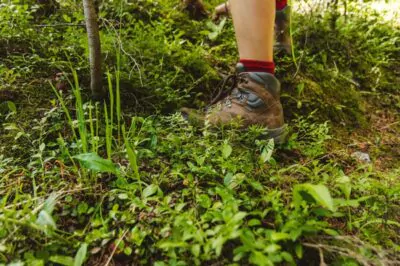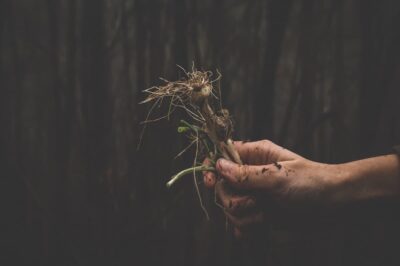Table of Contents[Hide][Show]
Contributed from our friend Sara Bir, author of The Fruit Forager’s Companion: Ferments, Desserts, Main Dishes, and More from Your Neighborhood and Beyond, which includes this excerpt on rose hips.
We all know the benefits of roses. They’re pretty and they smell great. But that’s just the flowers. What about the other parts—the hips, for instance? That’s the fruit of the rose. They’re packed with vitamin C, give herbal tea blends a pucker zing, and have various medicinal applications. Once you learn more about them, you’ll start looking at roses in bloom and imagining how round and full their hips might be later.
I forage for rose hips, among other fruit, and I talk about the pleasures of foraging as a practice and lifestyle in my new book, The Fruit Forager’s Companion: Ferments, Desserts, Main Dishes, and More from Your Neighborhood and Beyond (Chelsea Green Publishing, May 2018). It’s a how-to with recipes aimed at getting you excited to look at everyday plants anew. Like…roses. Keep reading for an excerpt.
Wild Fruit Serum – Brightening Facial Complex
Rosehip Seed Oil for Skin, Anti-Aging with Vitamin A & Essential Fatty Acids
A Nourishing Iron Tonic Recipe
Foraging for Rose hips
The petals of roses get all the attention, even in culinary terms— rose petal jam! Quails in rose petal sauce! Rose petals deployed as foofy garnishes! Petals are soft and delicate and immediately identifiable as part of a rose, even to a plant nincompoop. Rose hips are hairy, seedy, tart, and bulbous, and only prominent after the rose itself has long ago spent its showiness. I think of cute boys in high school who unfailingly dated the most boring, listless girls possible: skinny and soft-spoken with long hair and scrunchies that matched their outfits. Those girls were the rose petals. People who prefer more oomph keep their eyes peeled for the hips.
What to look for
Select your rose hips carefully. Commercially grown roses are notorious targets for generous applications of chemical fertilizers and pesticides. A lot of roses produce scrawny hips, too. You want big, buxom, colorful hips free of harsh chemicals. If rose hips were women, the ones you’d want would look like R. Crumb drew them.
Those rose hips come from what’s known as fruiting roses. Rrrow! Sounds foxy! Ramanas rose (R. rugosa) is native to Asia but naturalized here. It likes sandy coastal areas but grows inland in sunny spots, too. You’ll find it in the Northeast and Midwest, primarily. The blooms are showy and white, pink, or purple with yellow centers—rosy but not too rosy looking. Prairie rose (R. arkansana) is a native North American rose growing in the Plains and Midwest. Their fruits are about 1⁄2 inch (1.3 cm) across.
You are not limited to the collection of hips from domesticated roses only, though most likely wild rose hips will be smaller than cultivated ones. Consider that the most plentiful rose hips, those of the multiflora rose, are tiny and tasteless. I see them in the woods in the fall looking like itty-bitty red berries, and I’m tempted to give them a shot, though they barely have any flesh on them.
harvesting and storage
Deadheading roses will lop off their ovaries, and therefore the fruit, so if you’re growing your own and you want hips, don’t deadhead them.
Rose hips ripen from August through October, but cool weather helps them taste better. Not all rose hips are created equal. Sample before you pick, because some rose hips look fat and lovely but have zero flavor. Pick rose hips after they’ve attained a deep orange or red and ideally been exposed to a frost. You’ll want to get to them before they get too soft. Firm rose hips are tart, and the softer ones with just a bit of wrinkle are sweeter. (I’ve heard that freezing and then thawing harvested rose hips can replicate the flavor-building reaction of a frost, but I have not tried it myself.) Every rose has its thorn, so come pre- pared and either wear gloves or don’t make sudden jerky movements.
Refrigerate rose hips after harvesting to keep their nutrient content high. For long-term storage, dry the rose hips as is or freeze them, lopping off the tail and top ends first. A dehydrator dries them faster, but there’s a much higher success rate drying rose hips slowly spread out on sheet trays.
Culinary Possibilities
High in pectin, rose hips are great for jams and jellies. You can dry them and use them in herbal tea infusions (pick up most any given box of Celestial Seasonings tea, and there’s a 50 percent chance rose hips will be an ingredient).
To make a tea of dried hips, use only 2 teaspoons hips to 1 cup (240 ml) of boiling water and steep for 10 to 15 minutes. Sweeten with honey and enjoy.
Rose hips have very hard, large seeds. Any preparation where they will be strained or forced out—teas, jams, jellies, purees—makes handling them far less time consuming. This includes fresh and dried rose hips. Nyponsoppa, rose hip soup, is a Swedish porridge-y fruit dessert made with simmered, sweetened, and pureed rose hips (fresh or dried). The warm soup would have been a thrifty way for winter-bound Swedes to get their vitamins from a forgeable item. Today one can purchase instant mixes of the soup. It’s traditionally served with almond macaroons.
About the Author: Sara Bir is a chef and a writer. A graduate of The Culinary Institute of America, she creates recipes that draw on her professional skill set, yet are realistic for home cooks. Bir has worked as a chocolate factory tour guide, sausage-cart lackey, food editor, recipe tester, restaurant critic, librarian, and arts and entertainment reporter. Her writing has been featured in publications like Saveur and Edible Ohio Valley and on the websites Serious Eats, Lucky Peach, and Paste Magazine. She lives in Ohio. Find her at www.sausagetarian.com.





